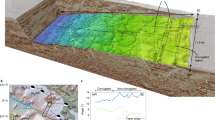Abstract
The world's largest earthquakes occur along the contact between subducting and overriding tectonic plates in subduction zones1. Rock and sediment properties near this plate interface exert important controls on the frictional behaviour of faults and earthquake rupture dynamics2. An important material property to define along the plate interface is the rigidity (the resistance to shear deformation). Rigidity affects the degree of earthquake shaking generated by a given fault displacement through its influences on seismic wave speed and earthquake rupture velocity. Here we present an investigation of the relationship between the duration of earthquake rupture and source depth, which yields estimates of rigidity variation along plate interfaces in six subduction zones in the circum-Pacific region. If stress drop is assumed constant, rigidity appears to increase with depth in each seismogenic zone by a factor of ∼5 between depths of 5 and 20 km. This result is consistent with the hypothesis that ‘tsunami’ earthquakes (characterized by large slip for a given seismic moment and slow rupture velocity) occur in regions of low rigidity at shallow depths3,4,5. These rigidity trends should provide an important constraint for future fault-zone and earthquake-modelling efforts.




Similar content being viewed by others
References
Kanamori, H. Rupture process of subduction-zone earthquakes. Annu. Rev. Earth Planet. Sci. 14, 293–322 (1986).
Scholtz, C. The Mechanics of Earthquakes and Faulting (Cambridge Univ. Press, (1990).
Kanamori, H. Mechanism of tsunami earthquakes. Phys. Earth Planet. Inter. 6, 246–259 (1972).
Fukao, Y. Tsunami earthquakes and subduction processes near deep sea trenches. J. Geophys. Res. 84, 2303–2314 (1979).
Pelayo, A. M. & Wiens, D. A. Tsunami earthquakes: slow thrust faulting events in the accretionary wedge. J. Geophys. Res. 97, 15321–15337 (1992).
Bilek, S. L. & Lay, T. Variation of interplate fault zone properties with depth in the Japan subduction zone. Science 281, 1175–1178 (‘998).
Bilek, S. L. & Lay, T. Comparison of depth dependent fault zone properties in the Japan trench and Middle America trench. Pure Appl. Geophys. (in the press).
Ruff, L. J. Multi-trace deconvolution with unknown scale factors: omnilinear inversion of P and S waves for source time functions. Geophys. Res. Lett. 16, 1043–1046 (1989).
Tichelaar, B. W. & Ruff, L. J. Seismic coupling along the Chilean subduction zone. J. Geophys. Res. 96, 11997–12022 (1991).
Ruff, L. J. & Miller, A. D. Rupture process of large earthquakes in the northern Mexico subduction zone. Pure Appl. Geophys. 142, 101–171 (1994).
Christensen, D. H. & Ruff, L. J. Analysis of the trade-off between hypocentral depth and source time function. Bull. Seismol. Soc. Am. 75, 1637–1656 (1985).
Kanamori, H. & Anderson, D. L. Theoretical basis of some empirical relations in seismology. Bull. Seismol. Soc. Am. 65, 1073–1095 (1975).
Vidale, J. E. & Houston, H. The depth dependence of earthquake duration and implications for rupture mechanics. Nature 35, 45–47 (1993).
Ekstrom, G. & Engdahl, E. R. Earthquake source parameters and stress distribution in the Adak Island region of the central Aleutian Islands, Alaska. J. Geophys. Res. 94, 15499–15519 (1989).
Houston, H., Benz, H. M. & Vidale, J. E. Time functions of deep earthquakes from broadband and short-period stacks. J. Geophys. Res. 103, 29895–29913 (1998).
Plank, T. & Langmuir, C. H. The chemical composition of subducting sediment and its consequences for the crust and mantle. Chem. Geol. 145, 325–394 (1998).
von Huene, R. & Scholl, D. W. Observations at convergent margins concerning sediment subduction, subduction erosion, and the growth of continental crust. Rev. Geophys. 29, 279–316 (1991).
Tera, F.et al. Sediment incorporation in island-arc magmas: Inferences from 10Be. Geochim. Cosmochim. Acta 50, 535–550 (1986).
Kimura, G.et al. Proc. ODP Init. Rep.Costa Rica accretionary wedge. 170, 1–458 (1997).
von Huene, R. & Lallemand, S. Tectonic erosion along the Japan and Peru convergent margins. Geol. Soc. Am. Bull. 102, 704–720 (1990).
Suyehiro, K. & Nishizawa, A. Crustal structure and seismicity beneath the forearc off northwestern Japan. J. Geophys. Res. 99, 22331–22347 (1994).
Vrolijk, P. On the mechanical role of smectite in subduction zones. Geology 18, 703–707 (1990).
Peacock, S. M. The importance of blueschist–eclogite dehydration reactions in subducting oceanic crust. Geol. Soc. Am. Bull. 105, 684–694 (1993).
Ihmlé, P. F., Gomez, J.-M., Heinrich, P. & Guibourg, S. The 1996 Peru tsunamigenic earthquake: broadband source process. Geophys. Res. Lett. 25, 2691–2694 (1998).
Kanamori, H. & Kikuchi, M. The 1992 Nicaragua earthquake: a slow tsunami earthquake associated with subducted sediments. Nature 361, 714–716 (1993).
Satake, K. Mechanism of the 1992 Nicaragua tsunami earthquake. Geophys. Res. Lett. 21, 2519–2522 (1994).
Heinrich, P., Schindelé, F., Guibourg, S. & Ihmlé, P. M. Modeling of the February 1996 Peruvian tsunami. Geophys. Res. Lett. 25, 2687–2690 (1998).
Tichelaar, B. W. & Ruff, L. J. Depth of seismic coupling along subduction zones. J. Geophys. Res. 98, 2017–2037 (1993).
Dziewonski, A. M. & Anderson, D. L. Preliminary reference Earth model. Phys. Earth Planet. Inter. 25, 297–356 (1981).
Acknowledgements
Data were obtained through the IRIS datacenter. This work was supported by the US NSF. We thank S. Schwartz and E. Silver for comments on early drafts.
Author information
Authors and Affiliations
Corresponding author
Supplementary information
Supplementary Information
Supplementary Information (PDF 272 kb)
Rights and permissions
About this article
Cite this article
Bilek, S., Lay, T. Rigidity variations with depth along interplate megathrust faults in subduction zones. Nature 400, 443–446 (1999). https://doi.org/10.1038/22739
Received:
Accepted:
Issue Date:
DOI: https://doi.org/10.1038/22739
- Springer Nature Limited
This article is cited by
-
Trench-parallel ridge subduction controls upper-plate structure and shallow megathrust seismogenesis along the Jalisco-Colima margin, Mexico
Communications Earth & Environment (2023)
-
Similar seismic moment release process for shallow and deep earthquakes
Nature Geoscience (2023)
-
Fault displacement hazard estimation at lifeline–fault crossings: A simplified approach for engineering applications
Bulletin of Earthquake Engineering (2023)
-
Source Characteristics of the 18 November 2022 Earthquake (\({M}_{W}\) 6.7), Offshore Southwest Sumatra, Indonesia, Revealed by Tsunami Waveform Analysis: Implications for Tsunami Hazard Assessment
Pure and Applied Geophysics (2023)
-
Stress, rigidity and sediment strength control megathrust earthquake and tsunami dynamics
Nature Geoscience (2022)





